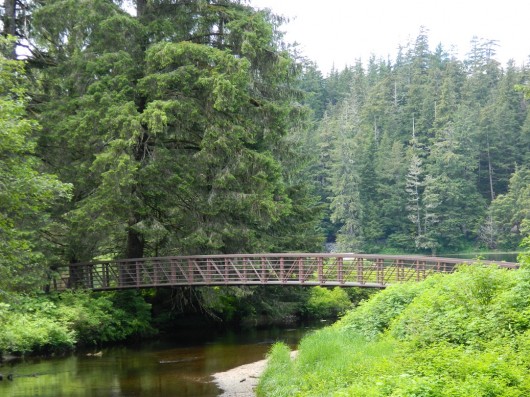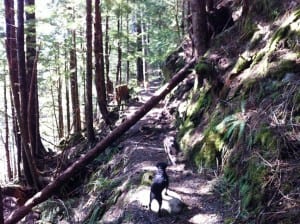
Ward Lake Recreation Area is unique, and will continue to be funded through the Tongass National Forest’s new “niche” funding formula.
Congress has cut the U.S. Forest Service budget for recreation nearly in half over the past five years. In response, Tongass National Forest officials have come up with a new way to allocate funds: Niches. If it’s in the niche, it’s funded. If it’s not in the niche? Well…
The Forest Service’s recreation program has gotten pretty bare-bones over the past few years. Seasonal crews are smaller, and the regular staff has shrunk through attrition –not replacing people when they leave a position.
You may not have noticed the belt-tightening yet, because local districts can apply for special-project funding through federal programs such as Secure Rural Schools and the American Reinvestment and Recovery Act. Those programs are not an assured source of funding, though, and the Forest Service is looking for ways to live within its means.
What does that mean to the public? To start, cabins and trails won’t be maintained the way they used to be.
Clark Simpson is a Ketchikan-Misty Fiords recreation program manager.
“As this money’s been dwindling over the last 5 years, the Tongass Leadership Team has been discussing what we need to do to be sustainable as a recreation program,” he said. “We need to be able to function on the money that’s allocated to us, and we can’t. I’ve supported us through getting money from other sources. And we can’t function like that. And this isn’t unique to Ketchikan. This is across the whole region.”
The solution they came up with is niches. Each ranger district has some service it provides that’s unique. The districts were able to choose three niches each, and that’s where the money will go. Period.
For Ketchikan, Simpson said the three niches are “Ward Lake, which is kinda unique. In essence, it’s like a city park but it’s run by the Forest Service, and it’s very popular. We have flightseeing out in Misty Fiords, and we have Misty Fiords in general. When the tourists come to Ketchikan, a lot of them are like, ‘I want to go flightseeing in Misty Fiords.’ And the other thing that was chosen is, we have a bear viewing area in Hyder. They’re probably getting 15,000-25,000 people a year.”
That leaves a whole bunch of recreation resources in the district unfunded. Like cabins. If they’re in Misty Fiords, then they’re in the niche, but there’s a bunch that aren’t. Such as Helm Bay, Helm Creek, Fish Creek and Naha.
In the short term, people using the cabins first will notice the lack of firewood, because Forest Service crews won’t be going out there to restock the wood pile. Soon after, depending on use, visitors will notice overflowing outhouses, because nobody is going out to pump them.
“Then beyond that, you start to develop deferred maintenance,” Simpson said. “The roof leaks, but we haven’t gotten around to fixing the roof leaking and that leads to bigger problems over time. Then we’ll start to talk about what we can and can’t keep. So, these cabins that aren’t part of a niche are definitely… yeah. That’s what the meeting is about.”
That meeting Simpson mentioned is an open house that’s coming up soon,. Simpson and other Forest Service officials will present information about the budget cuts, and what it means to the district, in hopes of hearing ideas and suggestions from people who use the forest for recreation, such as hikers.
Hiking trails within the Ward Lake niche – Ward Lake, Ward Creek, Perseverance, Salvage and probably Connell — will be maintained. But there are popular trails outside of that niche, such as Deer Mountain and Lunch Creek.
“The essence of what we do is log out and brush the trails,” Simpson said. “So if trees blow down, we cut the tree off the trail. And they do brush in really quick in the rainforest, so we try and get out and brush them fairly frequently. The brushing and the logout will probably be the first thing that people notice. So, you go to hike your local trail, and there will be a bunch of trees down that you have to crawl over or around.”
So what can members of the public do? Simpson says first, they can let Congress know how important recreation is to them. They also can volunteer, but in a way that doesn’t further tax the agency’s dwindling resources.
“What we’d really like is for somebody to be a lead for a group, and then we just have one point of contact and they do all the coordinating,” Simpson said. “It would be great if we had a volunteer group that had a lot of focus, and had somebody who was a really motivated coordinator, and came to us and said, ‘Hey we’ve got five people that want to work on a trail for a few days. What’s a good trail that we can access and do good work on?’”
Those are the kinds of ideas and suggestions Simpson hopes to hear at the upcoming meeting. He expects he’ll also hear some negative comments from people who didn’t realize this was coming.
“I think it is going to be a shock to the public when we just come out and say, ‘Hey! We don’t have the money to keep all this stuff that you’ve been using for a long time open, so we’re looking for ideas,’” he said.
And for those who are angry about this situation? Simpson says he’s right there with them. Over the past 14 years, he says he’s invested a lot of time and energy maintaining those cabins and tails. He doesn’t want to let them go, either, but “there’s not much we can do about not receiving money from Congress. If Congress chooses not to support recreation, I don’t really know what to say. Write your congressman.”
In the short term, though, Simpson said people can tell the Forest Service which facilities matter the most to them and what they’re willing to do to help.
The public meeting about recreation program funding is set for 5:30 p.m. May 8 at the Southeast Alaska Discovery Center.






